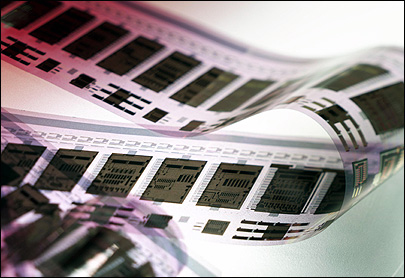At the Organic Electronics Conference and Exhibition 2006, PolyIC, a German startup that calls itself the “Chip Printer,” announced its success in using a roll-to-roll printing process to create passive 13.56 MHz RF (radio frequency) tags. Although the printed transponders emit an RF signal in response to a signal transmitted by an interrogator, they are not RFID tags because they do not communicate an ID number.
The conference was held Sept. 25-27 in Frankfurt, Germany. Some 300 people attended three days of sessions and workshops focused on organic electronics, also known as plastic electronics. Organic electronics are devices based on conductive polymers, or plastics, containing carbon-based molecules—hence, the name organic—and are not generally expected to challenge the dominance of systems relying on inorganic semiconductors such as silicon. Instead, they are believed to stand on their own for separate applications, such as creating low-cost RFID transponders that can be printed in mass production.
PolyIC’s president, Wolfgang Mildner—acting chairman of the Organic Electronics Association—displayed rolls of printed 13.56 MHz RF prototype tags to journalists and conference attendees. Mildner said the prototypes were the first RF tags ever produced worldwide in a roll-to-roll printing process.
The company developed the tags in close cooperation with Leonhard Kurz, a specialist in hot stamping and coating. PolyIC was founded as a joint venture between Kurz and Siemens. Previously, PolyIC had produced the same technology in a clean-room environment. The milestone with this latest announcement is that the tags have now been printed. These tags are made with printed polymer electronic components, including ring oscillators and other logic circuits, applied to foil-based antennas. The company would disclose only one of the materials it is using: polythiophene, necessary to create the semiconductor. The entire tag is produced in a roll-to-roll process that, unlike a batch process, allows for continuous production and high-speed capabilities.
PolyIC is calling the tags RF tags because they work on the same principle as RFID tags but do not communicate an ID number. Instead of containing unique ID numbers, these very simple passive RF tags—just like their silicon cousins used in theft-protection applications—communicate a “unique answer” when interrogated by giving off a different “noise” that the reader detects.
The firm explained that certain customers are testing the RF tags for such applications as brand-forgery protection. PolyIC would not reveal the companies’ names. “We are showing that we are, step by step, working toward a printed RFID tag,” Mildner said. PolyIC expects to bring the first printed HF RFID tags to market in 2007, but it won’t say if the debut will be at the beginning or end of the year. The company’s competitor, Organic ID, also represented at the conference, said it has not yet developed an RF or RFID tag and does not know when it would bring such a product to market.
PolyIC’s tags may be of interest to makers of high-value goods such as in the pharmaceutical industry, which loses millions of dollars each year due to counterfeiting. Eckhard Braun of Eurografica Systemplanungs, a consultancy for the packaging industry, held a separate talk about RFID labels in packaging. He stressed that RFID, or “smart” packaging, needs to be part of an integrated product strategy. “The whole process of brand management gets more complex with the addition of smart packaging,” he said.
Manufacturing capacity for organic electronics is still in its infancy, but is beginning to show signs of making the transition from R&D to initial production, said Craig Cruckshank, CEO of market research firm Cintelliq, which specializes in the organic semiconductor market and runs the annual Organic Electronics Conference. At this year’s event, Cruckshank said the manufacturing infrastructure needed to meet forecasted demand would require $400 million in investment during the next three years. Some $200 million has already been invested during the past 36 months. According to Cintelliq, the market is expected to be worth $1.4 billion within five years.
“If you look at the item-level market, what that market needs is a simple RFID chip that is very inexpensive,” said Klaus Dimmler, CEO of Organic ID. “They don’t need a more complex tag. It needs to be very small and very cheap—something that can be attached to each item. This is not a world silicon can compete in.”
Gerhard Finking, head of the microsystems division at the Bundesministerin für Bildung und Forschung (BMBF) (Germany’s ministry of education and research), agrees. “Hanging onto the silicon line [of thinking] would lead to an eroding international competitive situation,” Finking stated. The BMBF is investing millions in organic electronics research, including tests of RFID applications.
“We are planning to put much effort into the development of organic electronic-based RFID,” Finking said, adding that materials must still be developed to improve manufacturing in order to attain low-cost, high-volume production.
BMBF research money is already going to one such project, called Prisma (“PRinted SMArt RFID labels”). This project is being organized by VDI/VDE Innovation + Technik, executed by PolyIC.
Founded as a joint venture between Leonhard Kurz and Siemens, PolyIC is developing printed tags in close cooperation with Kurz, a specialist in hot stamping and coating. For the Prisma venture, three application fields will be tested: airline baggage, event ticketing and security documents. The project will compare the performance of polymer RFID tags with that of traditional silicon-based RFID tags. The three-year project began in September 2005.



